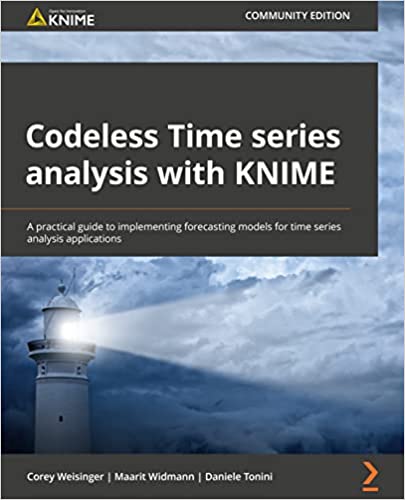Maarit is the co-author of Codeless Time series analysis with KNIME. We got the chance to sit down with her and find out more about her experience of writing with Packt.
Q. What is/are your specialist tech area(s)?
Maarit: Time-series analysis, scoring metrics, teaching data science.
Q: How did you become an author for Packt? Tell us about your journey. What was your motivation for writing this book?
Maarit: I am a teacher in the L4-TS Introduction to Time Series Analysis course together with the co-authors of the book. Thus, I am an author of many of the existing time series use cases in KNIME and proficient in the theory of time series analysis. Furthermore, in my position as a data scientist at KNIME, I teach data science concepts in articles, videos, and courses, and writing a book about time series analysis was an interesting challenge to improve as a data science educator and author.
In general, the time series functionalities of KNIME Analytics Platform are relatively new and time series analysis is a popular data science topic at the moment, which motivated us to promote the KNIME time series functionalities with this book. Furthermore, my colleagues Rosaria Silipo and Kathrin Melcher had previously written the “Codeless Deep Learning with KNIME” book with Packt, and the popularity of that book convinced us that there is an audience for such a book about time series analysis as well.
Q: What kind of research did you do, and how long did you spend researching before beginning the book?
Maarit: I mainly reviewed existing time series use cases and looked for the associated theory in, for example, the slides of the Introduction to Time Series Analysis course by KNIME.
Q: Did you face any challenges during the writing process? How did you overcome them?
M: Firstly, I found it challenging to connect the sections of the book chapter with introductory and lead-in sentences because this practice is different from writing a data science article. However, I learned this during the writing process thanks to feedback from the Packt editors. It was especially helpful to work on the commented documents because they indicated exactly what I am supposed to change.
Secondly, it was challenging to explain the process details verbally and rely less on workflow images. In my regular work as a data science author, I write mostly to an online audience where there are fewer restrictions on the usage of images and other content than written text.
Q. What’s your take on the technologies discussed in the book? Where do you see these technologies heading in the future?
M: Time series use cases exist in every industry and with a codeless implementation, more and more businesses can leverage the potential of time series analysis.
Q: Why should readers choose this book over others already on the market? How would you differentiate your book from its competition?
M: For experienced KNIME users, this book provides useful information about time series analysis, which is a specific field of data science. For experienced data scientists, this book shows an accessible and codeless implementation of advanced time series use cases in the open-source software KNIME Analytics Platform.
Q. What are the key takeaways you want readers to come away from the book with?
M: Explain the main components of time series data
Demonstrate the exploration of time series data in KNIME Analytics Platform
Execute a forecasting application in KNIME Analytics Platform
List available KNIME time series functionalities
Recognize different applications of time series analysis
Q. Can you share any blogs, websites, and forums to help readers gain a holistic view of the tech they are learning?
M: https://www.knime.com/blog
https://medium.com/low-code-for-advanced-data-science
http://forum.knime.com/
http://knime.com/knime-self-paced-courses
http://hub.knime.com/
https://www.youtube.com/user/KNIMETV
Q. How did you organize, plan, and prioritize your work and write the book?
M: Timewise, I followed the preliminary schedule that we sent to Packt in the planning phase and dedicated one full week per chapter. However, I didn’t write actively for more than a few hours per day. I also put a lot of other work aside because writing the book is a time and energy-consuming commitment. In the writing process, I started writing even before all the details were clear to overcome the empty paper as soon as possible. I also invested a lot of time in proofreading to make each chapter easy and insightful to read.
Q. What is that one writing tip that you found most crucial and would like to share with aspiring authors?
M: Address the feedback properly.
Q. What advice would you give to readers learning tech? Do you have any top tips?
M: Practice the implementation in parallel with learning the theory. This helps you demonstrate your learning and reflect your comprehension of the topic. Also, follow the step-by-step introductions in the book to complete an advanced use case in manageable pieces.
Q. How would you describe your author journey with Packt? Would you recommend Packt to aspiring authors?
M: The writing journey was intense and educational. I enjoyed the respectful and flexible working relationship with Packt and I can recommend Packt as a data science publisher, also for first-time authors like me.
You can find Maarit’s book on Amazon by following this link: Please click here.









